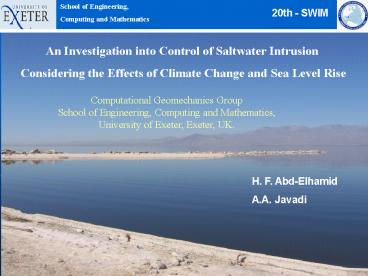An Investigation into Control of Saltwater Intrusion - PowerPoint PPT Presentation
1 / 17
Title:
An Investigation into Control of Saltwater Intrusion
Description:
Computational Geomechanics Group School of Engineering, Computing and Mathematics, University of Exeter, Exeter, UK. H. F. Abd-Elhamid A.A. Javadi – PowerPoint PPT presentation
Number of Views:155
Avg rating:3.0/5.0
Title: An Investigation into Control of Saltwater Intrusion
1
School of Engineering, Computing and Mathematics
20th - SWIM
An Investigation into Control of Saltwater
Intrusion Considering the Effects of Climate
Change and Sea Level Rise
Computational Geomechanics Group School of
Engineering, Computing and Mathematics,
University of Exeter, Exeter, UK.
H. F. Abd-Elhamid A.A. Javadi
2
School of Engineering, Computing and Mathematics
20th - SWIM
Outline
- ? Saltwater intrusion problem
- ? The main causes of Saltwater intrusion
- ? The impact of climate changes and sea level
rise on SWI - ? Measures to control SWI
- ? The limitations of the previous methods to
control SWI - ? The proposed methodology to control SWI
- ? The objectives of 2D-FEST model
- ? Model results
- ? Conclusions
3
Saltwater Intrusion
- ? Coastal regions (70 of population)
- ? Population growth
- ? Increase water demands
- ? Increase the extraction from aquifers
- ? Saltwater intrusion migration
- ? Salinization (2-3)
- ? Abandonment of freshwater supply
- ? SWI control
4
The main causes of Saltwater intrusion
1- Human activities - Over-pumping 2- Natural
events - Climate changes - Sea level rise -
Tides ? Climate change - Human activities
(global worming) - Natural changes
(volcanoes, sun) ? Sea level rise - Thermal
expansion of seas oceans - Melting of
glaciers and ice caps - Melting of Antarctic ice
sheets
5
Estimation of sea level rise - Last Century
(10-20) cm (IPCC1996) - Current Century (20-88)
cm (IPCC2001) ? The combined impact of
sea level rise and over-pumping on SWI
6
Measures to control Saltwater Intrusion
- 1.Reduce pumping rates.
- 2. Relocate pumping wells.
- 3. Subsurface barrier
- 4. Natural recharge
- 5. Artificial recharge (injection wells)
- 6. Extraction wells
7
5- Artificial recharge (injection wells)
- - Surface spread (unconfined)
- - injection wells (confined)
- - Injected water may be from
- (surface water, ground water,
- treated waste, desalinated
- seawater.)
6- Extraction wells
- Extract brackish water - Dispose it to the
sea
8
The limitations of the previous methods to
control SWI
- ? Short term solution (population growth)
- ? Not efficient for deep aquifers
- ? Availability of fresh water for recharge
- The cost of Fresh water
- Using treated waste water for recharge
- Using desalinated sea water for recharge
- ? Disposal of brackish water to the sea and the
effects on marines, fishing and tourism ? Sea
level rise due to climate change not considered
9
The proposed methodology (ADR)
- 1-(A) Abstract brackish water
- 2-(D) Desalinate brackish water using
- (RO)
- 3-(R) Recharge the desalinated brackish
- water (part)
- Advantages
- 1- Increase fresh water storage
- 2- Decrease saline water volume
- 3- Control saltwater intrusion
- 4- Increase water resources
- Overcomes shortcomings of previous methods
- - RO availability and cost of fresh water
- - Recovery rate (70-90)
- - Disposal of brine (30-10)
10
The objectives of the 2D-FEST Model
- Develop a coupled transient finite element model
for computing solute transport through
saturated/unsaturated soils. - Study saltwater intrusion of miscible solute
transport (density-dependant) - Use the developed model predict the extent and
solute concentrations - Study the effect of sea level rise due to climate
change on saltwater intrusion for the current
century (IPCC 2001). - Use the developed model to study the control of
saltwater intrusion using different scenarios. - Study the efficiency of the proposed methodology
to provide a new source of water for coastal
regions.
11
The steps of the proposed project
- 1- Simulate SWI and predict salts extent and
concentrations - 2- Simulate the effect of sea level rise due to
climate changes (20-88 cm/century) - 3- Simulate different scenarios to control SWI
(Recharge wells - Abstraction wells - Combination
of Abstraction Recharge wells) - 4- Simulation - Optimization
- (location depth - rates)
12
Model results
- 2D-FEST Model
- Henry (1964)
13
Model results
- 2D-FEST Model
- Henry (1964)
14
Sea level rise
10
20
15
Model results
- 2D-FEST Model
- SUTRA Code
- - INTERA Code
- Henry (1964)
16
Conclusions
- The developed coupled transient finite element
model gave good results to predict the extent and
solute concentrations in coastal aquifers. - The developed model can be used to Study
saltwater intrusion of miscible solute transport
(density-dependant). - The developed model can be used to study the
effects of sea level rise on saltwater intrusion. - Future (cont. current) work
- Use the developed model to study the control of
saltwater intrusion using different scenarios. - Simulation - Optimization models.
- 21th SWIM.
17
School of Engineering, Computing and Mathematics
20th - SWIM
Thanks Q A































